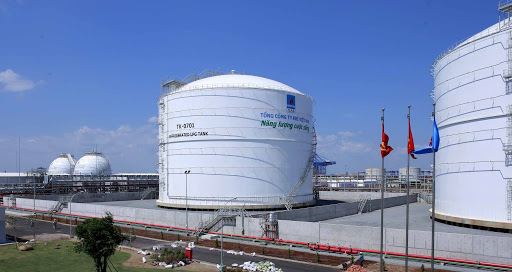Circular 41: Regulations on safety of liquefied petroleum gas supply stations in Vietnam
Regulations on safety of liquefied petroleum gas supply stations in Vietnam are specified in Circular 41/2011/TT-BCT on safe management in the field of liquefied petroleum gas, issued by the Ministry of Industry and Trade on December 16, 2011.

Circular 41: Regulations on safety of liquefied petroleum gas supply stations in Vietnam (Internet image)
Circular 41/2011/TT-BCT regulates safety of liquefied petroleum gas (LPG) supply stations in Vietnam as follows:
1. General provisions for LPG supply stations in Vietnam
The LPG supply stations must implement provisions from Article 3 to Article 6 of this Circular and the following requirements:
- To abide by provisions from Article 37 to Article 40 of the Decree 107/2009/ND-CP and granted certificate of eligibility of LPG supply station.
- The main items such as tanks, pipelines, vaporizers must be surrounded by fences, places cannot to lay fences, the main items must placed in the boundary fences of establishments.
- It must ensure convenience for fire-fighting vehicles to go out and enter stations when necessary.
- Equipments placed in areas having risk of damage must be protected by safety measures such as barriers, iron poles, concrete poles and there are warning panels. The safe equipment must not effect to aeration of areas storing LPG.
- To fast come places where customers using LPG to remedy unsafe malfunctions when receiving notice of customers.
2. Provisions for LPG tanks in Vietnam
The tanks installed in LPG supply stations must ensure provisions in Article 8 and Article 9 of this Circular and the following requirements:
- Not lay tanks in basements.
- Distance from LPG tanks to tanks containing other flammable liquids with burning point under 60oC is not less than 7 m.
3. Provisions for LPG supply stations by system of bottles
- The permitted maximum capacity of the bottle warehouse is 1000 kg.
- It may put the bottle-containing warehouses in civil-industrial houses when capacity is less than 700 kg and must ensure air ventilation, safety in fire and explosion prevention. The bottle-containing warehouses must be separated with other parts of the building by barriers, ceilings, closed floors, with the fire-resistance limit not less than 150 minutes.
- Warehouses containing bottles with system of contributed bottles must be put in houses with roof made of non-inflammable materials.
- Warehouses containing bottles outside of civil, industrial houses must be seperated completely with other buildings or the boundary fences of the adjacent works with minimum distance of 1 m for warehouses with capacity of under 400 kg; 3 m for warehouses with capacity of between 400 kg and 1000 kg.
4. Provisions for vaporizers
When using vaporizers in LPG supply stations, it must comply with the following provisions:
- It allows installing only vaporizers ensuring safety and explosion prevention and must placed far from tanks or bottles at least 1.5 m, far from the nearest buildings at least 3 m.
- When putting vaporizers in buildings, vaporizers are placed only at the first floor (ground-floor) and the first floor is not lower than the surrounding premises, it must be aerated.
5. Provisions for areas receiving LPG from cistern trucks in Vietnam
- At the entry for cistern trucks, it must have notice plate for restraining of speed.
- Areas receiving cistern trucks must have notation marked clearly, must have notice plates of position receiving cistern trucks and do not allow persons no duty to go around when putting LPG in the tanks.
- The head of cistern truck during receiving LPG must direct toward main path or the rescue path in order to not be obstructed when evacuating urgently.
6. Use of fire-isolated walls
- The fire-isolated walls must have no hole, built firmly by bricks, concretes, or other materials, must ensure the fire-resistance limit at least 150 minutes.
- Height of the fire-isolated walls of warehouses must be higher than the tanks at least of 0.5 m.
More details can be found in Circular 41/2011/TT-BCT, which comes into force from February 1, 2012.
Thuy Tram
- Key word:
- Liquefied Petroleum Gas
- Vietnam
- Number of deputy directors of departments in Vietnam in accordance with Decree 45/2025/ND-CP
- Cases ineligible for pardon in Vietnam in 2025
- Decree 50/2025 amending Decree 151/2017 on the management of public assets in Vietnam
- Circular 07/2025 amending Circular 02/2022 on the Law on Environmental Protection in Vietnam
- Adjustment to the organizational structure of the Ministry of Health of Vietnam: Certain agencies are no longer listed in the organizational structure
- Vietnam aims to welcome 22-23 million international tourists in Vietnam in 2025
-

- Number of deputy directors of departments in Vietnam ...
- 15:04, 05/03/2025
-

- Cases ineligible for pardon in Vietnam in 2025
- 14:43, 05/03/2025
-

- Decree 50/2025 amending Decree 151/2017 on the ...
- 12:00, 05/03/2025
-

- Circular 07/2025 amending Circular 02/2022 on ...
- 11:30, 05/03/2025
-

- Adjustment to the organizational structure of ...
- 10:34, 05/03/2025
-

- Notable new policies of Vietnam effective as of ...
- 16:26, 11/04/2025
-
.Medium.png)
- Notable documents of Vietnam in the previous week ...
- 16:21, 11/04/2025
-
.Medium.png)
- Notable documents of Vietnam in the previous week ...
- 16:11, 02/04/2025
-
.Medium.png)
- Notable new policies of Vietnam to be effective ...
- 16:04, 02/04/2025
-
.Medium.png)
- Notable new policies of Vietnam effective from ...
- 14:51, 21/03/2025
 Article table of contents
Article table of contents
